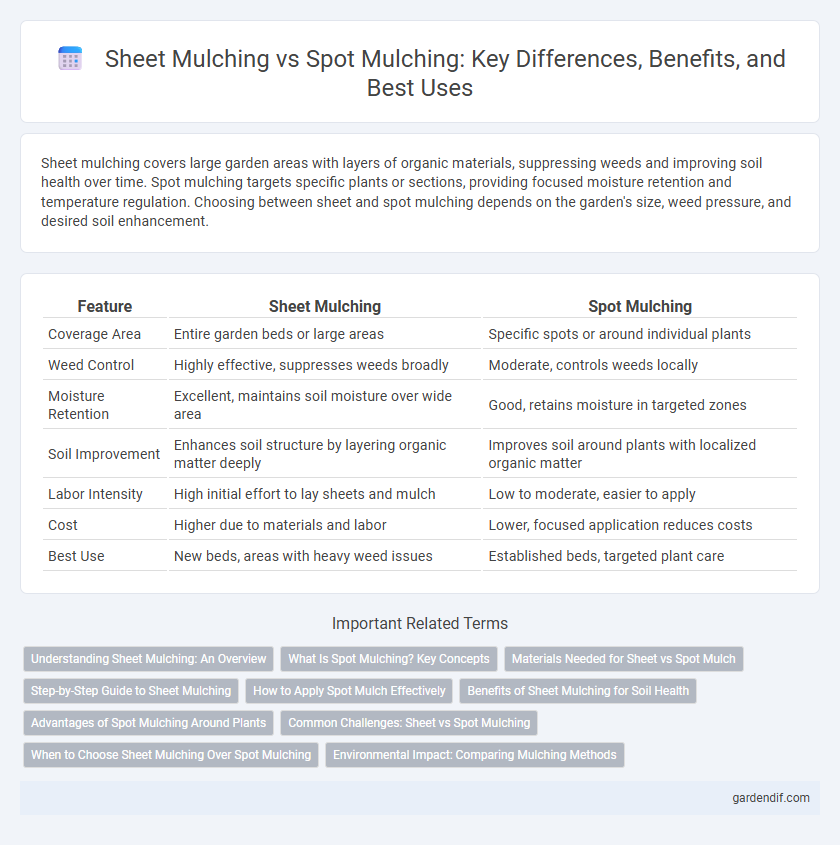
Sheet Mulching vs Spot Mulching Illustration
Sheet mulching covers large garden areas with layers of organic materials, suppressing weeds and improving soil health over time. Spot mulching targets specific plants or sections, providing focused moisture retention and temperature regulation. Choosing between sheet and spot mulching depends on the garden's size, weed pressure, and desired soil enhancement.
Table of Comparison
| Feature | Sheet Mulching | Spot Mulching |
|---|---|---|
| Coverage Area | Entire garden beds or large areas | Specific spots or around individual plants |
| Weed Control | Highly effective, suppresses weeds broadly | Moderate, controls weeds locally |
| Moisture Retention | Excellent, maintains soil moisture over wide area | Good, retains moisture in targeted zones |
| Soil Improvement | Enhances soil structure by layering organic matter deeply | Improves soil around plants with localized organic matter |
| Labor Intensity | High initial effort to lay sheets and mulch | Low to moderate, easier to apply |
| Cost | Higher due to materials and labor | Lower, focused application reduces costs |
| Best Use | New beds, areas with heavy weed issues | Established beds, targeted plant care |
Understanding Sheet Mulching: An Overview
Sheet mulching involves covering large soil areas with overlapping organic materials like cardboard, compost, and mulch to suppress weeds, improve soil health, and retain moisture. This method promotes soil microbial activity and nutrient cycling by gradually breaking down the layers, enhancing long-term garden fertility. Compared to spot mulching, which targets specific plants, sheet mulching provides comprehensive ground coverage that transforms entire garden beds or landscapes efficiently.
What Is Spot Mulching? Key Concepts
Spot mulching targets specific areas around plants to conserve moisture, suppress weeds, and improve soil health by applying mulch only where it is needed most. This technique maximizes resource efficiency by concentrating organic material near the root zones, enhancing nutrient availability and preventing over-mulching. Commonly used in raised beds or container gardens, spot mulching supports plant growth while minimizing potential fungal issues associated with excessive mulch coverage.
Materials Needed for Sheet vs Spot Mulch
Sheet mulching requires large quantities of organic matter such as cardboard or newspaper sheets, compost, and a thick layer of mulch like wood chips or straw to cover broad areas effectively. Spot mulching involves smaller amounts of materials, primarily organic mulch like bark or leaves, applied selectively around individual plants or garden spots. Both methods benefit from nutrient-rich compost but differ significantly in the volume and application scope of materials needed for optimal soil health and moisture retention.
Step-by-Step Guide to Sheet Mulching
Sheet mulching involves layering organic materials like cardboard, compost, and mulch directly over the soil to suppress weeds and improve soil health. Start by removing lawn or debris, then lay down a water-permeable barrier such as cardboard or newspaper, followed by adding a thick layer of compost and topped with mulch to retain moisture and support microbial activity. This step-by-step approach enhances soil fertility, reduces erosion, and promotes sustainable landscaping compared to targeted spot mulching, which only covers specific areas.
How to Apply Spot Mulch Effectively
Spot mulching requires placing organic material such as wood chips or compost directly around the base of plants to conserve moisture and suppress weeds efficiently. Focus on creating a 2-4 inch layer around stems without touching them to prevent rot and allow air circulation. Applying spot mulch in targeted high-need areas reduces resource waste and enhances soil health in specific zones.
Benefits of Sheet Mulching for Soil Health
Sheet mulching enhances soil health by creating a thick, oxygen-rich layer that suppresses weeds, retains moisture, and encourages beneficial microbial activity, leading to improved nutrient cycling and soil structure. This method promotes long-term fertility through gradual organic matter decomposition, increasing earthworm populations and fostering a balanced soil ecosystem. In contrast to spot mulching, sheet mulching provides comprehensive coverage, reducing soil erosion and temperature fluctuations for healthier plant growth.
Advantages of Spot Mulching Around Plants
Spot mulching around plants conserves moisture more efficiently by targeting the root zone, reducing water waste and enhancing plant health. It minimizes material usage and labor compared to sheet mulching, making it cost-effective for smaller garden areas or individual plants. This precise application also helps suppress weeds and moderate soil temperature, promoting optimal growth conditions for specific plants.
Common Challenges: Sheet vs Spot Mulching
Sheet mulching often faces challenges related to moisture retention and weed suppression due to uneven layering, whereas spot mulching struggles with inconsistent coverage that can leave soil exposed and vulnerable to erosion. Both methods encounter difficulties in balancing organic material decomposition rates, which impacts nutrient availability and soil health over time. Managing labor intensity and material costs also differs, with sheet mulching requiring more initial effort, while spot mulching demands frequent reapplication to maintain effectiveness.
When to Choose Sheet Mulching Over Spot Mulching
Sheet mulching is ideal for large areas with poor soil quality or heavy weed infestation, as it smothers weeds while enriching the entire soil bed. Choose sheet mulching when establishing new garden beds or renovating vast landscape sections to improve soil structure and moisture retention uniformly. Spot mulching suits targeted plant protection but lacks the comprehensive benefits provided by sheet mulching for large-scale soil improvement.
Environmental Impact: Comparing Mulching Methods
Sheet mulching, which involves covering large areas with layers of organic materials, enhances soil health by improving moisture retention and reducing erosion, creating a more sustainable environment. Spot mulching targets specific plants or areas, minimizing material usage but offering less comprehensive soil protection and weed suppression. Environmental impact favors sheet mulching for larger-scale applications due to its superior ability to promote biodiversity and reduce chemical runoff.
Sheet Mulching vs Spot Mulching Infographic

 gardendif.com
gardendif.com